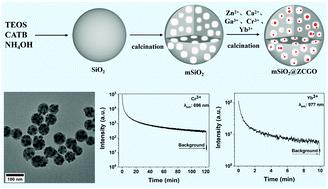当前位置:
X-MOL 学术
›
J. Mater. Chem. B
›
论文详情
Our official English website, www.x-mol.net, welcomes your
feedback! (Note: you will need to create a separate account there.)
Multiple emission bands NIR-persistent luminescence mSiO2@Zn0.6Ca0.4Ga2O4:Cr3+,Yb3+ nanoparticles for biological applications
Journal of Materials Chemistry B ( IF 6.1 ) Pub Date : 2020-12-19 , DOI: 10.1039/d0tb02552f Yaling Lin 1, 2, 3, 4, 5 , Jie Hu 4, 5, 6, 7, 8 , Luyan Wu 4, 5, 6, 7, 8 , Qilin Zou 9, 10, 11, 12, 13 , Dejian Chen 4, 5, 6, 7, 8 , Decai Huang 4, 5, 6, 7, 8 , Hongyu Lu 4, 14, 15, 16 , Shi-Bin Wang 1, 2, 3, 4 , Haomiao Zhu 4, 5, 6, 7, 8
Journal of Materials Chemistry B ( IF 6.1 ) Pub Date : 2020-12-19 , DOI: 10.1039/d0tb02552f Yaling Lin 1, 2, 3, 4, 5 , Jie Hu 4, 5, 6, 7, 8 , Luyan Wu 4, 5, 6, 7, 8 , Qilin Zou 9, 10, 11, 12, 13 , Dejian Chen 4, 5, 6, 7, 8 , Decai Huang 4, 5, 6, 7, 8 , Hongyu Lu 4, 14, 15, 16 , Shi-Bin Wang 1, 2, 3, 4 , Haomiao Zhu 4, 5, 6, 7, 8
Affiliation

|
Persistent luminescence nanoparticles (PLNPs) emitting in the NIR window (700–1700 nm) have shown great promise in the field of fluorescence imaging due to their unique properties, including the absence of in situ excitation and low optical scattering in tissues. However, they are still facing some challenges, such as irregular shape, wide size distribution and poor persistent luminescence performance. Here, we report a facile mesoporous template method for synthesizing mSiO2@Zn0.6Ca0.4Ga2O4:Cr3+,Yb3+ (mSiO2@ZCGO) persistent luminescent nanoparticles, which show a regular morphology and a size of about 69 nm. In addition, these nanocrystals exhibit persistent luminescence in multi-NIR windows, the first infrared window (∼696 nm of Cr3+ emission) and second infrared window (∼1000 nm of Yb3+ emission). Under illumination of a 254 nm UV lamp for 10 min, the persistent time of Cr3+ ions and Yb3+ ions lasted more than 120 min and 10 min, respectively. In particular, the NIR persistent emission of mSiO2@ZCGO could be stimulated by soft X-ray, which is beneficial to long-term imaging in deep tissues. The optical penetration length of Yb3+ ions persistent luminescence was evaluated to be 2.8 mm. These results demonstrate the great promise of mSiO2@ZCGO for deep-tissue bio-imaging.
中文翻译:

用于生物应用的多个发射带NIR持久发光mSiO2@Zn0.6Ca0.4Ga2O4:Cr3 +,Yb3 +纳米粒子
由于其独特的特性,包括在组织中不存在原位激发和低光学散射,在NIR窗口(700-1700 nm)中发射的持久发光纳米粒子(PLNP)在荧光成像领域已显示出巨大的希望。然而,它们仍然面临一些挑战,例如不规则形状,宽尺寸分布和差的持久发光性能。在这里,我们报告了一种简便的介孔模板方法,用于合成mSiO 2 @Zn 0.6 Ca 0.4 Ga 2 O 4:Cr 3+,Yb 3+(mSiO 2ZCGO)持久发光纳米粒子,其显示规则的形态和约69 nm的大小。此外,这些纳米晶体在多个近红外窗口,第一个红外窗口(约696 nm的Cr 3+发射)和第二个红外窗口(约1000 nm的Yb 3+发射)中显示持续发光。在254 nm紫外灯的照射下10分钟,Cr 3+离子和Yb 3+离子的持续时间分别超过120分钟和10分钟。特别是,可以通过软X射线激发mSiO 2 @ZCGO的NIR持续发射,这有利于深部组织的长期成像。Yb 3+的光穿透长度离子持久发光被评估为2.8mm。这些结果证明了mSiO 2 @ZCGO在深组织生物成像中的巨大前景。
更新日期:2021-01-12
中文翻译:

用于生物应用的多个发射带NIR持久发光mSiO2@Zn0.6Ca0.4Ga2O4:Cr3 +,Yb3 +纳米粒子
由于其独特的特性,包括在组织中不存在原位激发和低光学散射,在NIR窗口(700-1700 nm)中发射的持久发光纳米粒子(PLNP)在荧光成像领域已显示出巨大的希望。然而,它们仍然面临一些挑战,例如不规则形状,宽尺寸分布和差的持久发光性能。在这里,我们报告了一种简便的介孔模板方法,用于合成mSiO 2 @Zn 0.6 Ca 0.4 Ga 2 O 4:Cr 3+,Yb 3+(mSiO 2ZCGO)持久发光纳米粒子,其显示规则的形态和约69 nm的大小。此外,这些纳米晶体在多个近红外窗口,第一个红外窗口(约696 nm的Cr 3+发射)和第二个红外窗口(约1000 nm的Yb 3+发射)中显示持续发光。在254 nm紫外灯的照射下10分钟,Cr 3+离子和Yb 3+离子的持续时间分别超过120分钟和10分钟。特别是,可以通过软X射线激发mSiO 2 @ZCGO的NIR持续发射,这有利于深部组织的长期成像。Yb 3+的光穿透长度离子持久发光被评估为2.8mm。这些结果证明了mSiO 2 @ZCGO在深组织生物成像中的巨大前景。











































 京公网安备 11010802027423号
京公网安备 11010802027423号